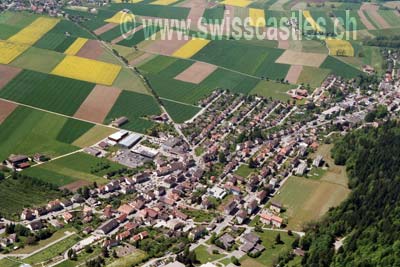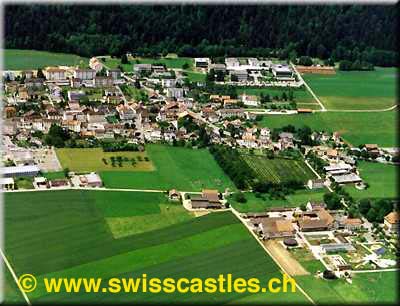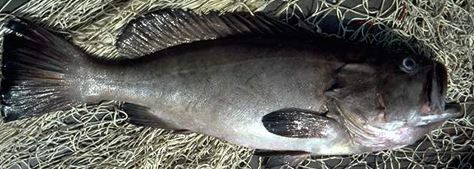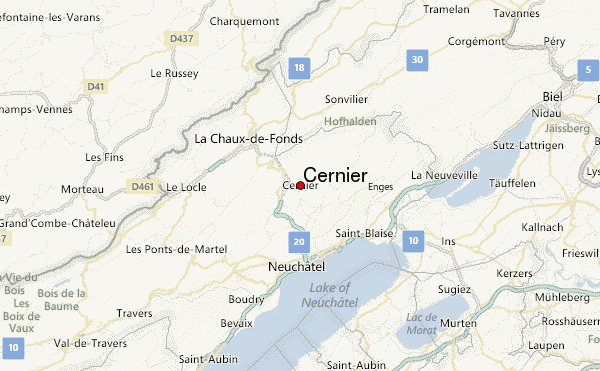Cernier
Cernier was a municipality in the district of Val -de- Ruz in the canton of Neuchâtel in Switzerland. On January 1, 2013, it merged with the municipalities Boudevilliers, Chézard -Saint- Martin, Coffrane, Dombresson, Engollon, Fenin- Vilars -Saules, Fontainemelon, Fontaines, Les Geneveys -sur- Coffrane, Les Hauts- Geneveys Montmollin, Le Pâquier, Savagnier and Villiers to the new municipality of Val -de- Ruz.
- 4.1 traffic
- 6.1 post
- 6.2 Kantonalbank
- 6.3 Church
- 6.4 schoolhouse
- 6.5 Municipal House / Town Hall
- 6.6 Cantonal Agricultural College
- 6.7 Site Cernier
Geography
Cernier is located on 820 m above sea level. M., 8 km north of the capital of the canton of Neuchâtel (air line). The municipality covers an elevated position on the northern edge of the basin Val de Ruz in the Neuchâtel Jura, at the foot of Mont d'Amin.
The area of 9.1 km ² large municipality area includes the southern part of a portion of the intensively farmed basin of the Val de Ruz. To the north, the area extends over the densely wooded steep slopes of the Côte Devant on the terrace of the Montagne de Cernier and on the anticline of Mont d'Amin. At this altitude is 1,410 m above sea level with. M. reached the highest point of the municipality. To the north of the summit of Mont d'Amin ranges of communal land in a narrow tip on the Montperreux ( 1'371 m above sea level. M. ) into the inlier La Grand ' Combe. The northern boundary of the municipality, at the same time cantonal border between Neuchâtel and Bern, runs along the crest of the L'Envers Convers (up to 1,231 m above sea level. M. ) on the southern edge of the Vallon de Saint- Imier. At the height of Mont- d'Amin chain is extended Jura high grazing pastures with the typical tall spruce trees that are either individually or in groups. From the municipality surface 1997 7 % was attributable to settlements, 39 % of forest and woody plants and 54% to agriculture.
To Cernier the hamlet Montagne de Cernier include ( 1'190 m above sea level. M. ) on a terrace on the southern slopes of Mont d'Amin and some individual farms. Neighboring communities of Cernier are Chézard -Saint- Martin, Engollon, Fontaines ( NE) and Fontainemelon in the Canton of Neuchâtel and Renan in the canton of Bern.
Population
With 2285 inhabitants ( 31 December 2012) Cernier belongs to the medium-sized municipalities in the canton of Neuchâtel. Of the 89.9 % inhabitants are French-speaking, German-speaking 3.3 % and 2.6 % speak Italian ( as of 2000). The population of Cernier posted a strong growth especially in the second half of the 19th century. At a further increase in population from 1950 to 1980 was followed by a period of stagnation before again an increase has been observed in recent years. The settlement area of Cernier has grown together almost seamlessly with that of Fontainemelon.
Government
Legislative: Conseil général
The General Council consists of 31 members and is elected by the people every four years by proportional system.
The General Council meets twice a year mandatory; once to adopt the budget for the coming year and once to discuss the bill last year. Furthermore, the legislature divided into committees that meet more frequently to discuss the question they area of church life. Extraordinary community meetings may be called by the people, the local council or at the request of members, which is usually done three to four times a year.
Executive: Conseil communal
The Conseil communal consists of five members elected by the General Council. Meetings are held as often as the current business requires, but usually at least once a week. Each member of the council is faced with one or more departments. The Presidency rotates in a 1 -year cycle.
The main task of the council is to manage the various areas of the community within the framework set by the Conseil général. The General Council acts as a supervisory body.
Economy
Cernier has long been a mainly coined by farming village. At the end of the 18th century, however, industrialization began with the introduction of watchmaking. Today, there are some small businesses in Cernier the watch industry, the printing industry, metal construction, mechanical workshops and carpentry. Agriculture has, thanks to the fertile soils in the valley of the Val de Ruz still of some importance: While in the basin dominates agriculture, is operated through the Jura hills cattle breeding and dairy farming. In recent decades, Cernier has also developed into a residential community. Many workers are commuters and work primarily in Neuchâtel or in La Chaux -de-Fonds.
Traffic
The community is easily accessible via. It is located on a link road from Les Hauts- Geneveys after Dombresson. The nearest links to the motorway H20, which connects Neuchâtel La Chaux -de-Fonds, is located just 2 km from the center. By bus, the TRN, which operate the route from Neuenburg to Cernier and Les Hauts- Geneveys in a circular course through the Val de Ruz, the place is connected to the public transport network. He was previously from 1903 to 1948 the tramway Les Hauts- Geneveys -Villiers through the town. It was replaced by the trolleybus Val de Ruz, which in turn was replaced in 1984 by the today 'Town Car buses.
History
The name Cernier is a derivation from the French word for Cernil enclosure. This Cernils are delineated by hedges and stone walls in the fields of law that arose among the Burgundians, to secure the work of small farmers before the free- grazing cattle.
Originally, the forest stretched on the slope of Mont d'Amin to Talfuss. Sometime in the 14th century left the Count of Valanginian clear the current municipal area, so that his people could cultivate the soil.
For centuries remained Cernier a small, insignificant farming village. Its growth began with the development of infrastructure. In the Middle Ages is apparently not much has happened. The church chronicles mention only the normal disputes between residents and some border disputes with neighboring communities Fontaines and Chézard.
In the 18th century a problem with bears and wolves is mentioned. Furthermore, the local peasants felt threatened by non -off in the streams of refugees from all over Europe. In the 1740s several times " Chasses aux gueux " ( " beggar hunts " ) are organized to expel people.
In 1813, 20 Dragoons of Archduke Jean had strayed to Cernier that were actually ordered by Serrières. When they noticed their mistake, they reacted angrily and threatened the villagers. They beat windowpane, hit the governor, called for wine and food and threatened to set the house on fire if it was not them to services. They calmed down and offered them alcoholic beverages. The next day the dragoons were sent to the correct way to Serrières. The incident cost the community in 1740 pounds (equivalent to 2,418 francs .60 ).
1875 Cernier handed a petition to be used in place of Fontaines main town of the valley community can. Fontaine did not respond to the topic and then the file was forwarded to the State Council of the Canton. Finally decided the cantonal government on November 21, 1877 due to the better financial position of the municipality to make Cernier to the main town of the administrative district of Val- de -Ruz.
On October 12, 1885, the Agricultural School Cernier was inaugurated. The idea for such a school was from Frédéric Soguel, and after a successful year of operation the school in 1886 cantonal agricultural college was made. The operation of this school was set in the 1890s and opened the site Cernier, an agricultural experimental station with attached cantonal vocational school for " Earth and Nature Occupations " ( Ecole Cantonal des Métiers de la Terre et de la Nature ), in the form as it still exists today.
1897, the Furniture Factory Jules Perrnoud & Cie founded in 1867, was converted into a public limited company. Jules Perrnoud end of the 19th century, the largest employer in the region.
From about 1890 a regional steam railway line was discussed between Villiers and Les Hauts- Geneveys similar to the Train Littoral between Neuchâtel Boudry and to build. It has been discussed for so long about whether narrow gauge or standard gauge that finally with the introduction of electricity solved the problem by itself: on 23 February 1903 by the population of the northern Val -de- Ruz was the electric streetcar, " Le Régional " inaugurated.
Structures
Post
When the post office in Switzerland was still a matter for the cantons, Cernier had only one mailbox ( from 1832), which was emptied twice a week. In 1849, the post has been federally and Cernier applied in Berne own post office. On April 1, 1852, the first post office was opened in Cernier. With the construction of the school building in 1856, the Post also moved a. 1904 the municipality bought the old farmhouse west of the school building, tore it down and built in its place the new post office building (now the Police Station). Since October 7, 1991, the post office is in the newly built village center.
Kantonalbank
The building of the Cantonal Bank was built in 1911 instead of a farmhouse in the village center. It was the only branch of BCN in the Val -de- Ruz. By 1990, the bank was in this building when she moved into the new building on the Rue Vergy. The old bank building was converted into a well-off house.
Church
The "temple" has been around since in 1453. During the 16th century it was rebuilt. The chorus is the same today as 1515th The chapel on the northern edge of the village was demolished in 1734 and rebuilt. 1782, the steeple of the 1875 re- converted " temple " with bells was fitted. The decorations inside are from the painter Charles L' Eplattenier from La Chaux -de-Fonds. The parsonage dates back from 1887.
Schoolhouse
The first school was opened in Cernier during the Reformation in 1531. A recording from 1649 shows that the school at that time was only open from November 5 to April 23, and took place in the hall of the town hall.
The old school house was built in 1856 by primary and secondary school was housed. From 1875 onwards an official, approved by the Canton of " Ecole secondaire du Val -de- Ruz ," a common Middle School for the communities of the district was created.
In 1896, the gymnasium was built, in 1898 the school building was completely renovated. Yet until 1970 was located on the ground floor of the gym a public indoor pool. The building is still used by local clubs.
In 1971 the new primary school was built at the edge of the forest, the old school was demolished and replaced by the present community center. The new secondary school " La Fontenelle " was inaugurated in November 1971 - 364 students were enrolled at the time.
Between 1991 and 1993, the Fontenelle was expanded to include a gymnasium, more classrooms and a new indoor pool, to meet the more than 700 pupils well.
Community center / hall
This could be Cernier 1877 main town of the district of Val -de- Ruz, it needed to provide adequate places available for administration. Since 1879, therefore, the public service has expanded enormously.
With the financial help of the canton of the Hôtel des services publics ( the later Hôtel de Ville) was planned and built. It had to have, among other things in addition to the normal administrative offices over a courtroom, prison cells, and an apartment for the local gendarmes.
On November 22, 1897, the new parish house was built in the village center. Today it houses the local administration, the District Court and various meeting rooms in that building.
Cantonal Agricultural College
On 16 November 1884, the local authorities decided to build a school for " practical agriculture ", " good farmers " form with the target. On October 12, 1885 this school was opened with twelve pupils.
At the beginning of the Agricultural School was a mid- Private Foundation, which was also co-financed by the municipalities and make profit from the canton. On the grounds of the Ferme de l' Aurore built, she was soon called Ecole de l' Aurore.
The enormous growth of students meant that the school had to be a year after the opening, in 1886, expanded already. The community Cernier had to ask to the canton to financial assistance, to which the State took the school under his wing and instead of the old school opened a Cantonal Agricultural School.
Since then, the school grew continuously and has a large impact on the local and cantonal primary economy.
Site Cernier
In 1995, the Cantonal agricultural school was completely reorganized in Cernier and had to make way to the site Cernier. The site Cernier is the cantonal vocational school for all the earth and Nature Occupations: landscaper, gardener, farmer ( with various specializations ), foresters, loggers, etc. are trained here today.
The site also has the task to sensitize the population of the Canton of ecological issues. This is done, inter alia, held annually by the Fête de la Terre ( "Earth Fest" ) and the Festival des jardins extraordinaires ( " Festival of the exceptional gardens).
In addition, here is a small zoological park with old breeds of domestic animals, where the development of the local domestic animals is presented since the late Middle Ages.










